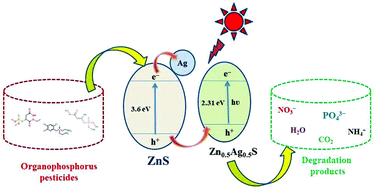当前位置:
X-MOL 学术
›
Photochem. Photobiol. Sci.
›
论文详情
Our official English website, www.x-mol.net, welcomes your
feedback! (Note: you will need to create a separate account there.)
Ternary semiconductor ZnxAg1−xS nanocomposites for efficient photocatalytic degradation of organophosphorus pesticides†
Photochemical & Photobiological Sciences ( IF 2.7 ) Pub Date : 2018-09-11 00:00:00 , DOI: 10.1039/c8pp00220g Dasari Ayodhya 1, 2, 3, 4 , Guttena Veerabhadram 1, 2, 3, 4
Photochemical & Photobiological Sciences ( IF 2.7 ) Pub Date : 2018-09-11 00:00:00 , DOI: 10.1039/c8pp00220g Dasari Ayodhya 1, 2, 3, 4 , Guttena Veerabhadram 1, 2, 3, 4
Affiliation

|
The construction of ternary semiconductor nanostructures has attracted much attention in photocatalysis by virtue of their tunable elemental composition and band structure. Here, ternary semiconductor ZnxAg1−xS (0 ≤ x ≤ 1) composites were successfully prepared by a simple and low-cost hydrothermal method without using any surfactant. Combined analyses using XRD, N2 sorption, SEM, TEM and UV-vis DRS revealed that the ternary composite semiconductor materials exhibited well-developed crystalline frameworks, large surface areas of 15–70 m2 g−1, sizes of 10–30 nm, and outstanding UV light absorption properties. Data from XRD and TEM indicate that photocatalysis might contribute to the formation of the strong interfacial interaction between ZnS and Ag2S nanoparticles. The photocatalytic activities were investigated via the degradation of organophosphorus pesticides, including malathion (MLT), monocrotophos (MCP) and chlorpyrifos (CPS), using the ZnxAg1−xS composites under UV light irradiation. The toxicity of MLT, MCP, and CPS was reduced by photocatalysis and photolysis; however, photocatalysis had a greater impact. Superior photocatalytic performance was exhibited by the Zn0.5Ag0.5S catalyst owing to its large surface area and the presence of Ag0 with improved charge transfer in comparison with that of bare ZnS and Ag2S. Assays of stability and reusability indicated that the Zn0.5Ag0.5S composite retained more than 85% of its activity after five cycles of use. On the basis of the results, a possible photocatalytic mechanism of the prepared samples was proposed. This study indicates a potential application of the ternary semiconductor materials in the efficient UV light-driven photocatalytic degradation of other pollutants that may cause environmental pollution.
中文翻译:

可有效光催化降解有机磷农药的 三元半导体Zn x Ag 1- x S纳米复合材料†
三元半导体纳米结构的构造由于其可调节的元素组成和能带结构而在光催化中引起了很多关注。在此,三元半导体的Zn X银1- X S(0≤ X成功地通过简单的和低成本的水热法制备≤1)的复合材料,而不使用任何表面活性剂。使用XRD,N 2吸附,SEM,TEM和UV-vis DRS的组合分析表明,三元复合半导体材料表现出发达的晶体骨架,大表面积为15-70 m 2 g -1,尺寸为10–30 nm,并具有出色的紫外线吸收特性。XRD和TEM的数据表明,光催化作用可能有助于形成ZnS和Ag 2 S纳米粒子之间的强界面相互作用。使用Zn x Ag 1- x S复合材料在紫外线照射下,通过降解包括马拉硫磷(MLT),久效磷(MCP)和毒死rif(CPS)的有机磷农药来研究光催化活性。通过光催化和光解可以降低MLT,MCP和CPS的毒性。但是,光催化的影响更大。Zn 0.5 Ag 0.5表现出优异的光催化性能S催化剂由于其表面积大和与裸露的ZnS和Ag 2 S相比具有更大的电荷转移而存在Ag 0。稳定性和可重复使用性分析表明Zn 0.5 Ag 0.5 S复合材料保留了85%以上的S五个使用周期后其活性。根据结果,提出了一种可能的光催化机理。这项研究表明三元半导体材料在有效紫外光驱动的其他污染物的光催化降解中的潜在应用,这些污染物可能引起环境污染。
更新日期:2018-09-11
中文翻译:

可有效光催化降解有机磷农药的 三元半导体Zn x Ag 1- x S纳米复合材料†
三元半导体纳米结构的构造由于其可调节的元素组成和能带结构而在光催化中引起了很多关注。在此,三元半导体的Zn X银1- X S(0≤ X成功地通过简单的和低成本的水热法制备≤1)的复合材料,而不使用任何表面活性剂。使用XRD,N 2吸附,SEM,TEM和UV-vis DRS的组合分析表明,三元复合半导体材料表现出发达的晶体骨架,大表面积为15-70 m 2 g -1,尺寸为10–30 nm,并具有出色的紫外线吸收特性。XRD和TEM的数据表明,光催化作用可能有助于形成ZnS和Ag 2 S纳米粒子之间的强界面相互作用。使用Zn x Ag 1- x S复合材料在紫外线照射下,通过降解包括马拉硫磷(MLT),久效磷(MCP)和毒死rif(CPS)的有机磷农药来研究光催化活性。通过光催化和光解可以降低MLT,MCP和CPS的毒性。但是,光催化的影响更大。Zn 0.5 Ag 0.5表现出优异的光催化性能S催化剂由于其表面积大和与裸露的ZnS和Ag 2 S相比具有更大的电荷转移而存在Ag 0。稳定性和可重复使用性分析表明Zn 0.5 Ag 0.5 S复合材料保留了85%以上的S五个使用周期后其活性。根据结果,提出了一种可能的光催化机理。这项研究表明三元半导体材料在有效紫外光驱动的其他污染物的光催化降解中的潜在应用,这些污染物可能引起环境污染。











































 京公网安备 11010802027423号
京公网安备 11010802027423号